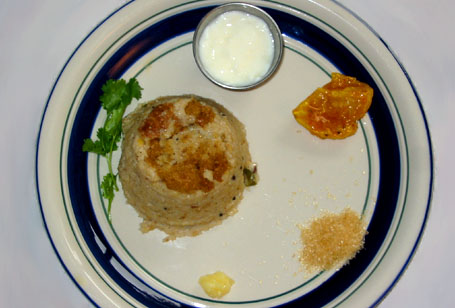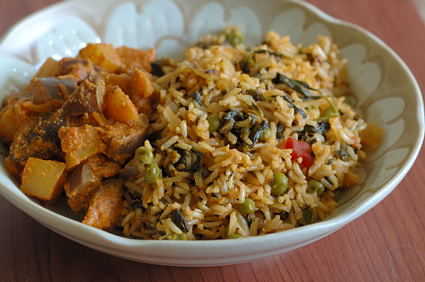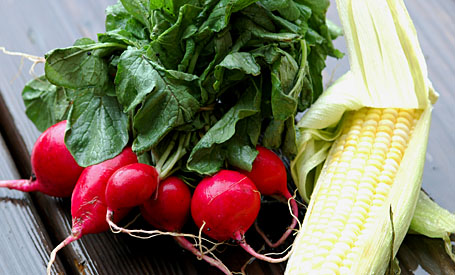Food blogging has opened a window for me to meet interesting and like-minded people who also share my passion and philosophy of cooking. Janani Srinivasan from Toronto is one such person. After reading her comments on some of my blogged recipes, I knew I found a friend and I had to ask her if she would be interested to share her family recipes on “Mahanandi”. She agreed enthusiastically and readily to my delight. Here she is, sharing her family’s treasured, traditional recipes in “The Arisiupma Trilogy”. Enjoy!
– Indira |
My fondest childhood memories are of mealtimes at the home of my maternal grandparents where my grandmother- Annapurani in nature as in name- would whip up meal after magical meal prompting my late grandfather to often say in Sanskrit “Anna dhaata sukhi Bhava” (May the giver of rice be happy). If the story of a people’s deepest aspirations can be seen in their metaphor, then this poetic conflation of rice as food itself speaks volumes to the centrality of grain in the foodscapes of India’s many cultures.
One of the other remarkable features of the Indian subcontinent, is that depending on what filter or combination of these that you use- language, religion, culture, region, social identity, you could carve it up into a delightful array of unique variants of regional cuisines.
If I were to cite the major culinary influences that shape my own approach to cooking, I would pick out, as my example, my paternal grandmother Vathsala’s austere, methodical, cooking-with-what’s-on-hand-to minimize-waste? Kumbakonam Iyer style, with Annapurani’s elaborate, lavish, incredibly rich preparations shaped by her own life in Hyderabad and Bangalore; to my mother Jayanthi’s innovative style from her many travels, her tendency towards the fiery twists of her life in the Rayalseema region but always with a strong adherence to the authentic approach of her own paternal grandmother.
So when Indira asked me to guest blog, I could not think of a better tribute to my heritage and to the food grain that has sustained generations of my family, than the humble “Arisiuppma” with two of its popular variations “Thavalaadai” and “Pudikozhakattai”.
Ingredients:
(a) For the “Upma Odasal” or the cracked rice meal:
Rice- 1 cup (Using Brown basmati for this takes it to a whole new level of dense nutty chewy perfection but regular basmati or ay other rice especially par-boiled rice is quite acceptable and is the norm)
Urad Daal– 1 tsp
Toor Daal– 2 tsp
Dried red chilies- 4- 6 (depending on the level of spice tolerance)
Black peppercorns- 1 tsp
Cumin seeds- 1 tsp

(b) Tadka or seasoning:
Mustard seeds- 1 tsp
Urad dal– 1 tsp
Few Curry leaves
Green chilies- 3 to 4, chopped finely into rounds
Ginger root- 1inch, finely chopped .
Fenugreek seeds- Just a tiny pinch (optional)
Asafoetida- a pinch (the extract of the solid version soaked in water is ideal but the powdered form is acceptable too)
Sunflower oil- 1 tbsp (It is normally used but if you have the gutsJ, coconut oil tadka will make this dish quite ethereal.)
(c) Garnish:
Freshly grated coconut a fistful (can be omitted if it’s not preferred or my paternal aunt’s variation is to substitute it with sauteed onions)
(d) Salt to taste

Procedure:
1 In a blender/food processor coarse grind the ingredients listed under “(a)” to a cracked wheat consistency.
2 In a wide-bottomed pan, heat the oil and do the tadka.
3 Once the seeds start to sizzle and splutter, add fresh water in the proportion 1: 3 rice meal and water.
4 Once the water starts to boil, add in the coarsely grinded “(a)” list of ingredients and mix well.
Now when I made it this time, I had to ensure that my pipeline was effective since I was making three dishes with the exact same ingredients. Typically, one would only make one of the three preparations at any given time.
Up to step 4 above is common to all 3 dishes. After this point, the procedure diverges for each preparation.
Pudikozhakattai (Steamed Cracked Rice Dumplings)

When the mixture is well mixed and the water is just absorbed, take it off the heat. Depending on your heat tolerance, try not to let it cool down too much. Work rapidly using some cold water to wet hands and roll it into balls. Steam for about 8-10 minutes till done. A special twist here is to bury a smidgeon of jaggery in the center of this so you stumble upon a heart of sweet goodness as a surprise while biting into it.
Thavaladai (Rice Lentil Croquets)

After step 4, take it off the heat. Once it’s cooled down shape into patties and shallow fry on a griddle. Can be served with ketchup or any chutney if desired or just plain.
Arisiupma

(Try as I might, I could not come up with a nifty English equivalent for this dish. Let’s hope this will enter the lexicon alongside the likes of Bulghur, Couscous and Cream of Wheat. )
Keep going from step 4 till the uppma is well done. To serve, especially for kids, a popular pairing is with some ghee and sugar. Pickle and yogurt is also a combination but mostly its just eaten plain and piping hot.
– Guest Post by Janani Srinivasan, Toronto
Jayasri Srinivasan – Ingredient lineups and picture arrangements
Dr.S.Ramachandran – Photographs






























